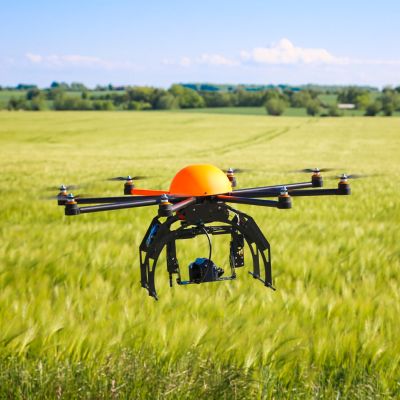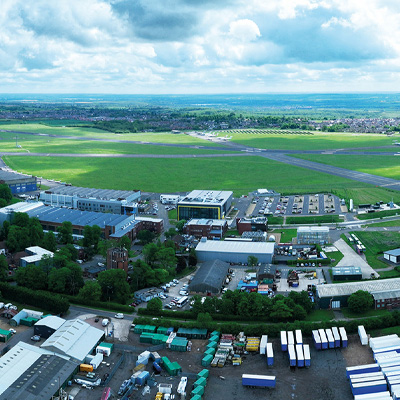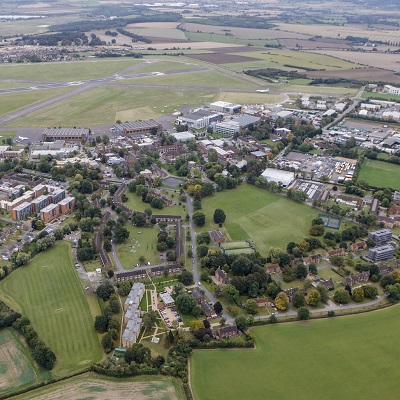Overview
- Start dateFull-time: October, part-time: October
- DurationOne year full-time, two-three years part-time
- DeliveryTaught modules 80 credits/800 hours, Group projects 40 credits/400 hours, Individual project 60 credits/600 hours
- QualificationMSc, PgDip, PgCert
- Study typeFull-time / Part-time
- CampusCranfield campus
Who is it for?
We welcome students from a variety of backgrounds who have a passion for technology and data. We bring together students who want to understand their role in sustainability and the new global economy, to solve real-world problems and make a positive global impact. You will gain experience of world-class spatial problem solving, as well as developing a range of personal and leadership skills to set you on the path for a rewarding career in any one of the growing range of industrial and research sectors that now routinely make use of geospatial information to solve global challenges.
Your career
Successful students develop diverse and rewarding careers in the spatial information industry, national and local government, consultancies, utilities, and research organisations. The international nature of this course means that career opportunities are not restricted to the UK. Cranfield graduates develop global careers and this course is internationally recognised by employers across the scientific, industrial and educational communities. Our practical and industry-led education makes our graduates some of the most desirable in the world for global employers to recruit.
The course is designed in direct collaboration with industry to provide you with the knowledge and practical skills to prepare you for a successful career across the full range of global sectors, including:
Environmental management, Natural resource management, Urban planning, Transportation planning, Emergency management, Science, Government and Business intelligence.
Our successful graduates who are highly skilled and sought-after professionals have pursued or enhanced their careers in a variety of key roles such as:
Data Scientist, Academic Researcher, GIS Technician, Geospatial Analyst, GIS Officer, Project Development Officer and Remote Sensing Scientist, at organisations such as Airbus and Cambridgeshire Acre.
Cranfield Careers and Employability Service
Cranfield’s Career Service is dedicated to helping you meet your career aspirations. You will have access to career coaching and advice, CV development, interview practice, access to hundreds of available jobs via our Symplicity platform and opportunities to meet recruiting employers at our careers fairs. Our strong reputation and links with potential employers provide you with outstanding opportunities to secure interesting jobs and develop successful careers. Support continues after graduation and as a Cranfield alumnus, you have free life-long access to a range of career resources to help you continue your education and enhance your career.
Cranfield supports international students to work in the UK after graduation
Studying at Cranfield was hugely fun and rewarding for me, and enabled me to land a better job. I chose Cranfield because the course modules sounded comprehensive and fun, including up-to-date subjects that would put me in a good position upon graduating, and because of its eagerness to work with industry partners.
I really enjoyed the short module format at the beginning of the year, and found working on self-contained projects very motivating. The group project was a great experience also, as it pushed me to work in a team in a new way, and to deliver on a real project for an industrial partner.
I now work as a GIS Technical Officer for the IUCN, a position that requires many of the skills I learned on the course.
The course struck a good balance between theory and hands-on practice, covering everything from GIS and spatial analysis to remote sensing, machine learning, and web mapping. What really made it stand out for me was the practical approach—getting to apply the concepts we learned to real-world scenarios was truly rewarding.
The faculty were friendly, knowledgeable, and supportive, bringing both academic and industry perspectives into the classroom. Because of Cranfield’s strong links to industry, the curriculum always felt in tune with what employers actually look for.
My experience on the Advanced GIS and Remote Sensing MSc course at Cranfield University was nothing short of transformational. From day one, the course was designed to provide both technical expertise and real-world applications.
The assignments were not just academic exercises—they prepared me for the workforce by requiring us to apply advanced spatial analysis and remote sensing techniques to solve real-world environmental and land-use challenges. The group project was particularly rewarding, allowing me to collaborate with industry professionals while still learning.
This course was a career booster, equipping me with in-demand geospatial skills and enhancing my job prospects in the rapidly evolving GIS and Earth Observation field.
My year at Cranfield pursuing MSc in GIS was intense but incredibly rewarding. The course pushed me to learn new skills, from core GIS to Python and web mapping, giving me the confidence to step into industry. The group project was a real highlight—getting to work with industry experts and tackle real-world problems made the learning experience even more valuable. It was challenging, but the support from faculty and peers made all the difference. I’ve come away with not just technical skills but also a problem-solving mindset that I know will serve me well in my career.
I chose the course because I see the great potential of geospatial data to enable effective decision making on environmental projects, and it exceeded all my expectations. The modules covered many aspects from remote sensing and advanced GIS to environmental surveying and coding, with challenging assignments helping us to learn through interesting, hands-on scenarios. I particularly enjoyed using Python to build a machine learning model to classify land cover in a hyperspectral satellite image. The group project and thesis offer opportunities to further develop your skills while collaborating with fellow students and industrial partners on real-world projects, and my thesis was a great asset when applying for jobs, helping me to land an exciting role shortly after graduating. The skills I’ve gained have set me on an exciting journey and will enable me to add real value as I work to combat environmental challenges.
My experience studying the MSc in Advanced GIS and Remote Sensing at Cranfield University has been transformative. From day one, the practical approach of the programme and the quality of teaching enabled me to acquire advanced technical and analytical skills that are directly aligned with industry demands. The access to state-of-the-art facilities and the support of expert professors in the field of geospatial sciences helped me overcome complex challenges and develop an innovative perspective in my area of specialisation. Moreover, the cultural diversity on campus and the opportunities to collaborate with students from around the world enriched my experience and expanded my professional network.
Why this course?
Advanced GIS and Remote Sensing is an exciting and rapidly growing branch of information technology (IT), incorporating and integrating satellite remote sensing, aerial photography and other spatial data, such as soil survey information, to derive reliable and up-to-date information which is essential for the sustainable use or conservation of the earth’s resources. This course will equip you with the skills and knowledge to develop an exciting career helping to address global issues in the geospatial sector.
Benefit from a practical approach to learning, gaining skills in geographical information systems, spatial analysis, machine learning, coding, image processing, remote sensing, data visualisation and cartography, and data science for a successful career in the rapidly expanding geospatial field.
You will also:
- Gain experience in the collection and processing of a wide range of geospatial data from satellite, manned and unmanned aircraft, and field survey, including processing of high-volume data in the cloud.
- Focus on identifying problems and creating resilient and sustainable solutions through the selection and integration of appropriate technologies.
- Learn via a varied combination of lectures, tutorials, real-world case studies and practical sessions led by Cranfield staff.
- You will gain practical, real-world experience through consultancy led individual and group projects, often supported by industry sponsors and focused on your personal interests and career aspirations.
- Apply the knowledge and skills that you learn on this course to issues such as climate change, improving farming yields, tropical deforestation, transportation, smart navigation systems, disaster response management, recreation, property management and telecommunications.
This master’s course is supported by our team of professional thought leaders, who have industry backgrounds and provide real-life learning challenges. Our teaching team are heavily involved in industrially funded research and development in digital environment, environmental monitoring, and resource survey. Our world leading research leads the course content and aligns it with the latest sector thinking. Our dedicated teaching team includes Professor Ronald Corstanje and Professor Stephen Hallett who are influential in the field of Environment and an integral part of this MSc. Our high student to staff ratio aims to deliver an excellent student experience and maximise your employability opportunities.
Informed by industry
The Advanced GIS and Remote Sensing MSc is designed to meet the relevant needs of global employers and benefits from a strong input from industry experts. This gives our students the confidence to know the course content aligns with the latest sector thinking and is beneficial to building a rewarding career.
- The applied GIS and related research our staff undertake is fed back into our GIS teaching programmes, ensuring all students who complete this MSc are equipped with cutting-edge expertise and skills.
- Double accreditation by The Royal Institution of Chartered Surveyors (RICS) and The Chartered Institution of Civil Engineering Surveyors (CICES) ensures that the course has been independently assessed as meeting current professional standards.
- Employers and partners ensuring that the MSc meets current industry demands for GI specialists include:
|
|
Course details
This course comprises eight modules, a group project and an individual project. Courses are not isolated from the real world and many are supported by research groups working on cutting-edge programmes.
Course delivery
Taught modules 80 credits/800 hours, Group projects 40 credits/400 hours, Individual project 60 credits/600 hours
Group project
The group project experience during the course is highly valued by both students and prospective employers. It provides you with the opportunity to take responsibility for a consultancy-type project while working under academic supervision. It also enables you to start building essential industry links and knowledge whilst studying.
The project involves the application and integration of component technologies:
- GIS
- GPS and remote sensing
- Field methods, and statistical analysis to produce quality-assured innovative solutions
Recent group projects include:
Individual project
The individual project is either industrially or University driven. You will be able to select the individual project in consultation with the course team and it will provide the opportunity to demonstrate independent research ability, the ability to think and work in an original way, contribute to knowledge, and overcome genuine challenges in relation to the management of the earth's resources. It also offers you the opportunity to work and build links with the types of organisation you will be seeking employment with on successful completion of the course.
Modules
Keeping our courses up-to-date and current requires constant innovation and change. The modules we offer reflect the needs of business and industry and the research interests of our staff and, as a result, may change or be withdrawn due to research developments, legislation changes or for a variety of other reasons. Changes may also be designed to improve the student learning experience or to respond to feedback from students, external examiners, accreditation bodies and industrial advisory panels.
To give you a taster, we have listed the compulsory and elective (where applicable) modules which are currently affiliated with this course. All modules are indicative only, and may be subject to change for your year of entry.
Course modules
Compulsory modules
All the modules in the following list need to be taken as part of this course.
GIS and Spatial Data Management
| Module Leader |
|
|---|---|
| Aim |
|
| Syllabus |
Spatial data models and database structures – vectors, rasters, topology, ordered and indexed lists, hierarchical, network, relational, object oriented, hybrid, metadata. |
| Intended learning outcomes |
On successful completion of this module you should be able to:
|
Aerial Photography and Digital Photogrammetry
| Module Leader |
|
|---|---|
| Aim |
Deriving digital elevation models and ortho imagery is an important application of remote sensing data for many areas of spatial work. This module introduces techniques for the extraction of topographic information from remotely sensed data using digital photogrammetry techniques. Image interpretation is also a vital skill required in many image based mapping projects. The concepts and techniques of image interpretation will be introduced and practised. |
| Syllabus |
|
| Intended learning outcomes |
On successful completion of this module you should be able to:
|
Scientific Python
| Module Leader |
|
|---|---|
| Aim |
|
| Syllabus |
Fundamentals of programming. |
| Intended learning outcomes |
On successful completion of this module you should be able to: Explain how computer code is used in science and engineering. Create Python code for solving set problems and develop confidence in writing code for your own projects. Analyse data using Python libraries and visualise results as graphs, maps and interactive figures. |
Applied Earth Observation
| Module Leader |
|
|---|---|
| Aim |
|
| Syllabus |
Physical principles:
|
| Intended learning outcomes |
On successful completion of this module you should be able to: Define the primary physical quantities that are directly related to measured radiance. Compare the nature of surface and atmospheric interactions with electromagnetic radiation between passive and active satellite sensors. Evaluate appropriate data for surface monitoring applications, considering how images are formed and the physical relations underlying the retrieval of satellite measured reflectance, temperature and backscattering coefficients. Analyse the complete remote sensing process from data reception to information extraction, including applying calibration and atmospheric correction methods to image data. |
Image Processing and Analysis
| Module Leader |
|
|---|---|
| Aim |
Extracting information from satellite, aerial and drone image data requires knowledge of a wide variety of image processing techniques. This module will give you the skills to select and apply appropriate image processing techniques for the extraction and analysis of information from image data for applications of remote sensing, for example in land use monitoring and surface change detection. |
| Syllabus |
Radiometric, spectral and spatial image enhancement: Contrast stretching (linear, bilinear, Gaussian, histogram equalisation and manual), digital filtering in the spatial domain (low-pass, high-pass, high-boost, median and directional). Band algebra: Derivation of soil and vegetation indices: ratios, normalised differences, PVI, SBI, tasselled cap concept. Geometric correction: Map projections, selection of ground control points, transform equations, resampling methods (nearest neighbour, bilinear interpolation, cubic convolution). Supervised and unsupervised image classification: Parametric and non-parametric techniques, clustering, segmentation, pixel and object-based approaches, machine learning, deep learning, and validation (accuracy assessment). Post processing, processing chains, change detection, cloud computing and applications. |
| Intended learning outcomes |
On successful completion of this module you should be able to: Evaluate a wide range of image processing techniques and their underlying mathematical principles. Select appropriate image processing sequences to achieve predetermined objectives. Operate and manage an image processing system. Integrate image processing techniques into applications of remote sensing. |
Advanced GIS Methods
| Module Leader |
|
|---|---|
| Aim |
GIS analyses are based upon increasingly sophisticated methods, but the results are subject to both error and uncertainty. A range of advanced methods are introduced that will have potential use to students in their group and thesis projects and their future careers. Emphasis will be given to the role of GIS in modelling environmental systems and the programming tools available to develop applications. |
| Syllabus |
|
| Intended learning outcomes |
On successful completion of this module you should be able to:
|
Environmental Resource Survey
| Module Leader |
|
|---|---|
| Aim |
This module covers the importance of environmental resource surveys that are required to obtain the data used in environmental information management. |
| Syllabus |
|
| Intended learning outcomes |
On successful completion of this module you should be able to:
|
Web Mapping
| Module Leader |
|
|---|---|
| Aim |
Geographical information is increasingly prevalent in our daily life, affecting personal leisure activities as much as the workplace. Geographical information represents a key theme in environmental management and, indeed, it has been estimated that some 80% of the data used for environmental, business and policy-oriented decision-making is geographical in nature. This poses challenges to its efficient and timely dissemination to stakeholders and potential end users. Today, the Internet offers a ubiquitous medium for real-time delivery of geographical information and location-based web services, across a range of computing platforms. |
| Syllabus |
|
| Intended learning outcomes |
On successful completion of this module you should be able to:
|
Teaching team
The course is taught by members of research and academic staff and industrial representatives.
The Course Director is Dr Daniel Simms and the Deputy Course Director is Dr Joanna Zawadzka.
Accreditation
The MSc in Advanced GIS and Remote Sensing is accredited by the Royal Institution of Chartered Surveyors and the Chartered Institution of Civil Engineering Surveyors.
Accreditation provides you with the assurance that the course has been independently assessed as meeting professional standards.
























